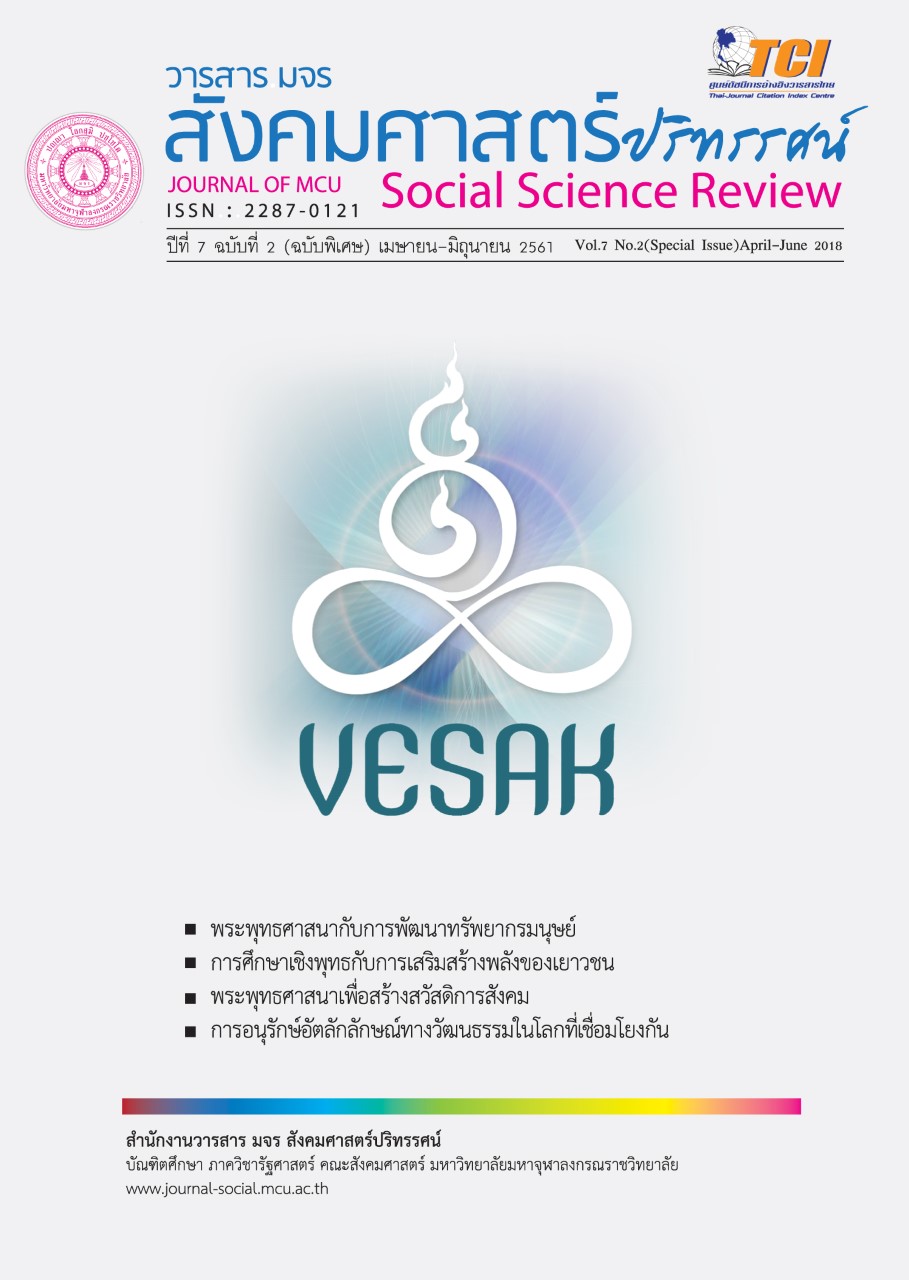การป้องกันการทุจริตในองค์กรปกครองส่วนท้องถิ่นด้วยกลไกพุทธบูรณาการ
คำสำคัญ:
การป้องกันการทุจริต, กลไกพุทธบูรณาการบทคัดย่อ
บทความนี้ มีวัตถุประสงค์เพื่อ1) วิเคราะห์สภาพการเอื้อประโยชน์ต่อการทุจริตที่มีต่อสังคมไทย 2)ศึกษารูปแบบการป้องกันการทุจริตขององค์กรปกครองส่วนท้องถิ่นต้นแบบตามแนวพระพุทธศาสนา และ 3)เสนอรูปแบบการป้องกันการทุจริตในองค์กรปกครองส่วนท้องถิ่นด้วยกลไกพุทธบูรณาการ
การวิจัยครั้งนี้เป็นการวิจัยเชิงคุณภาพ ผู้วิจัยได้ดำเนินการเก็บข้อมูลจากเอกสาร การระดมความคิดเห็นจาก โครงการประชุมเสวนาเครือข่ายการต่อต้านการทุจริต โดยอาศัยกลไกของรัฐเป็นเครื่องมือในการดำเนินการ ซึ่งมีกลุ่มเป้าหมายประกอบด้วย ผู้บริหารระดับสูงในระดับนโยบายและระดับปฏิบัติการ ได้แก่ บุคคลจากภาครัฐ/เอกชน/ประชาชนจากทั่วประเทศ การสัมภาษณ์เชิงลึกผู้บริหารระดับสูงหรือผู้ทรงคุณวุฒิจากหน่วยงานส่วนกลาง จำนวน 5 คน ผู้บริหารระดับสูงและบุคลากรในพื้นที่ 4 จังหวัด ที่มีองค์กรปกครองส่วนท้องถิ่นได้รับรางวัลพระปกเกล้าทองคำจำนวน 30 รูป/คน และการสนทนากลุ่มเฉพาะ(Focus Group Discussion) จากคณาจารย์และผู้ทรงคุณวุฒิจำนวน 9รูป/คนเพื่อยืนยันความถูกต้อง โดยวิเคราะห์ข้อมูลแบบอรรถาธิบายและพรรณนาความ
ผลการวิจัยพบว่า
1.สภาพการเอื้อประโยชน์ต่อการทุจริตที่มีต่อสังคมไทยแบ่งเป็น 2 ระดับ คือ (1) ระดับบุคคล ได้แก่ บุคลากรของรัฐขาดความรู้ความเข้าใจ ระเบียบแนวทางปฏิบัติตามระเบียบกฎหมาย การใช้ตำแหน่งหน้าที่แสวงประโยชน์หรือเอื้อประโยชน์ให้ตนเองและพวกพร้อง การขาดจิตสำนึกด้านคุณธรรมจริยธรรมในการปฏิบัติหน้าที่ และภาคประชาชนมีค่านิยมจ่ายสินบนให้แก่บุคลากรภาครัฐ เพื่ออำนวยความสะดวกในการรับบริการ เห็นว่าการทุจริตเป็นเรื่องปกติ ไม่เกี่ยวข้องกับตนเอง การร้องเรียนไม่กล้าระบุตัวบุคคล แต่ระบุองค์กร ทำให้กลไกการตรวจสอบการทุจริตเป็นไปได้ยาก (2) ระดับองค์กร เนื่องจากระบบราชการมีขั้นตอนยุ่งยากซับซ้อนทำให้บุคลากรภาครัฐอาศัยช่องว่างของกฎหมาย แสวงหาผลประโยชน์ที่มิควรได้ ในบางกรณีกฎระเบียบที่วางไว้ทำให้คนสุจริตไม่สามารถปฏิบัติหน้าที่ได้ ประกอบกับการวางระบบควบคุมภายในขาดประสิทธิภาพ กลไกการตรวจสอบการทุจริตจากหน่วยงานภายนอกรวมทั้งกระบวนการยุติธรรมล่าช้า ไม่ทันการณ์ การลงโทษด้านกฎหมายและด้านสังคมไม่รุนแรง
2.การป้องกันการทุจริตขององค์กรปกครองส่วนท้องถิ่นต้นแบบตามแนวพระพุทธศาสนา พบว่า องค์กรปกครองส่วนท้องถิ่น มีการบริหารจัดการด้านความโปร่งใสและส่งเสริมการมีส่วนร่วมของประชาชนภายใต้นโยบายยุทธศาสตร์ชาติ ว่าด้วยการป้องกันและปราบปรามการทุจริตโดยตระหนักถึงความสำคัญของหลักธรรมาภิบาล โดยเฉพาะหลักความโปร่งใสซึ่งมีตัวชี้วัดตามที่สถาบันพระปกเกล้ากำหนด และแบ่งรูปแบบการป้องกันการทุจริตเป็น 2 ระดับ ได้แก่ 1) ระดับบุคคล ด้วยการปลุกจิตสำนึกโดยปลูกฝังค่านิยมและทัศนคติให้บุคลากรมีความรู้ ความเข้าใจ ยึดหลักคุณธรรมจริยธรรม รณรงค์ให้รักษาศีลห้า ดำรงชีวิตตามหลักปรัชญาเศรษฐกิจพอเพียง 2) ระดับองค์กร ด้วยการนำหลักธรรมาภิบาลมาใช้ในการบริหารจัดการองค์กร ประสานงานกับองค์กรอิสระ ในการให้ความรู้ความเข้าใจและร่วมตรวจสอบองค์กรให้เกิดความโปร่งใสพร้อมทั้งเน้นกลไกการมีส่วนร่วมจากภาคประชาชนในการตรวจสอบกระบวนการดำเนินการบริหารจัดการท้องถิ่นทุกขั้นตอน
3.รูปแบบการป้องกันการทุจริตในองค์กรปกครองส่วนท้องถิ่นด้วยกลไกพุทธบูรณาการประกอบด้วยการดำเนินการใน 2 ระดับคือ (1) ระดับบุคคล ใช้หลักโลกบาลธรรม (หิริ โอตัปปะ) เป็นกลไกในการบูรณาการ เพื่อปลูกและปลุกจิตสำนึกของบุคคลในองค์กรให้เกิดความละอายต่อความชั่ว และเกรงกลัวต่อผลของการประพฤติชั่วพร้อมทั้งปลูกฝังค่านิยมคุณธรรมจริยธรรมซึ่งเป็นการพัฒนาที่จุดเริ่มต้นของคน (2) ระดับองค์กร ใช้หลักอปริหานิยธรรม 7 ซึ่งเป็นหลักธรรมที่ใช้ในการปกครอง เพื่อให้องค์กรเกิดความเข้มแข็ง มีความสามัคคีของหมู่คณะ ให้เกียรติซึ่งกันและกัน ปฏิบัติตามกฎระเบียบ เน้นความรับผิดชอบต่อส่วนรวม ยึดหลักขนบธรรมเนียมประเพณีและศาสนาเป็นกลไกบูรณาการร่วมกับหลักธรรมาภิบาล ขับเคลื่อนการบริหารจัดการองค์กรปกครองส่วนท้องถิ่นให้โปร่งใสปราศจากการทุจริตอย่างยั่งยืน
เอกสารอ้างอิง
ChitinanSukhiket. (2010). Trend on Anti-Corruption in Local Organization of Pakchong District.(Research Report).Khonkaen:Local Administration College, Khonkaen University.
EakTangsapwattana and staffs.(2011). Guidelines for applied international standard for anti-corruption of Thailand, Anti-Corruption Academic Journal, 4(1), 74-75.
Office of the National Anti-Corruption Commission.(2014). Handbook for Buddhist Corruption Training Curriculum in Secondary School level.Cooperation between Office of the National Anti-Corruption Commission and Mahachulalongkornrajavidayalaya University.
Office of the National Anti-Corruption Commission. (2014). Strategy for Anti-Corruption, Step 2 for 2556-2560. Nonthaburi.Corruption Protection Office.
PasukPongphaichit and staffs. (2014). Corruption in the Public Sector: Opinions and Experiences of Households.(Research Report).Research Supporting Fund Office.
PrateepMakmitra. (2007). Ethics of Higher Education Institutions Executives (Doctor of Thesis).Post Graduate School.Silapakorn University.
RaksaSudsenphom. (2014).Factors effects on Success of Decentralization to Local Administration Organization of Lower Northeast of Thailand(Doctor of Thesis).Post Graduate School: Mahachulalongkornrajavidayalaya University.
SurasakToprateep. (2010).Good Governance of Public Finance Management of Sub-District Local Administrative Organization.(Doctor of Thesis).
Post Graduate School: Ramkhamhaeng University.
ดาวน์โหลด
เผยแพร่แล้ว
รูปแบบการอ้างอิง
ฉบับ
ประเภทบทความ
สัญญาอนุญาต
ลิขสิทธิ์ (c) 2020 วารสาร มจร สังคมศาสตร์ปริทรรศน์

อนุญาตภายใต้เงื่อนไข Creative Commons Attribution-NonCommercial-NoDerivatives 4.0 International License.
เพื่อให้เป็นไปตามกฎหมายลิขสิทธิ์ ผู้นิพนธ์ทุกท่านต้องลงลายมือชื่อในแบบฟอร์มใบมอบลิขสิทธิ์บทความให้แก่วารสารฯ พร้อมกับบทความต้นฉบับที่ได้แก้ไขครั้งสุดท้าย นอกจากนี้ ผู้นิพนธ์ทุกท่านต้องยืนยันว่าบทความต้นฉบับที่ส่งมาตีพิมพ์นั้น ได้ส่งมาตีพิมพ์เฉพาะในวารสาร มจร สังคมศาสตร์ปริทรรศน์ เพียงแห่งเดียวเท่านั้น หากมีการใช้ภาพหรือตารางหรือเนื้อหาอื่นๆ ของผู้นิพนธ์อื่นที่ปรากฏในสิ่งตีพิมพ์อื่นมาแล้ว ผู้นิพนธ์ต้องขออนุญาตเจ้าของลิขสิทธิ์ก่อน พร้อมทั้งแสดงหนังสือที่ได้รับการยินยอมต่อบรรณาธิการ ก่อนที่บทความจะได้รับการตีพิมพ์ หากไม่เป็นไปตามข้อกำหนดเบื้องต้น ทางวารสารจะถอดบทความของท่านออกโดยไม่มีข้อยกเว้นใดๆ ทั้งสิ้น





